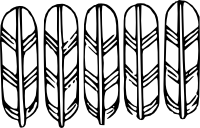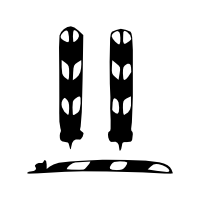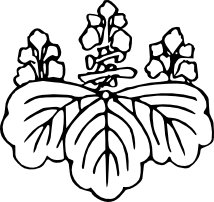Recreational research into Feudal Japan
Posts tagged Muromachi period
Primary Source: Kenmon Shokamon
Jun 5th (a Shakkō (赤口))
O-umajirushi is great for an idea of what mon were like in the Momoyama period, but what were they like before that? There are few earlier sources for mon other than depictions of battle scenes and similar. One that I have found, however, is Kenmon Shokamon (見聞諸家紋), which translates to “Various Observed Family Crests”. It’ss an excellent collection of a wide variety of earlier mon, some of which have been featured on this blog as “provincial samurai” mon. It was originally published around 1467–1470, and it features crests that were observed on the banners and camp curtains of the Ōnin War, which started the Sengoku period.(ja.wp:見聞諸家紋) It contains a variety of combinations and motifs that are rare or absent by the time of the later codifications. I recently got access to the full text of this source via Google Books and shenanigans, and it has plenty of interesting designs, featuring a wide selection of plovers and also including a phoenix, a horse, and a shrimp. It also features some unexpectedly pictorial designs that in some ways are more similar to the later Edo period designs than those in common use around the Momoyama period. Its selection of mon that combine multiple elements in different ways will be useful for those seeking to register mon in the SCA.
I haven’t had time for detailed analysis as of yet, but I present the text for your enjoyment:
On Kissing
Nov 22nd (a Tomobiki (友引))
Once, many years ago, I read the following in Shinjū, by Laura Joh Rowland, a mystery novel set in Edo Japan.
But he’d never tried seppun, the exotic practice of touching mouths that had been introduced to Japan by the banished foreign barbarians. (p. 123)
Being naturally a trusting sort, I took this at face value and assumed the Japanese hadn’t kissed before the Portuguese arrived in 1542. But more recently, I read an interesting passage in the Tosa Journal, written around 935 by a courtier.(CJP:77)
People simply kissed the lips of pressed salted trout. (I.e., nibbled at their heads.) Do you suppose the trout found it romantic?
Is this evidence of pre-Western-influence romantic kissing? Certainly looks like it. But absent other evidence, I had to wonder what exactly was in the original and if anything had been added in translation. Looking at the original, several things are clear. The expression here is “kuchi wo sufu”1, literally “suck lips”, which does seem to specifically be an idiom for kissing. The romantic bit turns out to be “omofu yau ara n ya”, something along the lines of “perhaps they helplessly have longing”, omofu having among its various possible interpretations ‘think of’, ‘recall fondly’, ‘long for’, ‘love’, and ‘cherish’. I think we can fairly say, then, that my doubts of Dr. McCullough’s translation were unmerited. As for Westerners having introduced romantic kissing to the Japanese, as we say in the biz, “Myth Busted!”
I have also posted a complete translation of these two sentences.
Many thanks to Mister Bean (ミスター ビーン), whose analysis and translation of this passage into modern Japanese was quite helpful.
Element of the Week: Feathers
Sep 27th (a Sembu (先負))
Today we look at a straightforward motif in mon: feathers. Generally described as hawk’s feathers (or, depending on translation, falcon’s feathers), they are graphically simple and have flexibility in number and arrangement. They have a military connotation, both from hawks being hunting birds and from the tradition of fletching arrows with feathers from birds of prey.(Kyudo) Falconry was also a popular and respected sport for both samurai and nobility from the Heian Period (794–1185).(Dower:94)
Here we have a simple 5-feather mon from the Muromachi-period collection of provincial samurai mon.(KJ:7) It shows the more free-form nature of earlier mon by being notably wider than it is tall, which became rarer as mon became more formalized.
 Watch movie online The Lego Batman Movie (2017)
Watch movie online The Lego Batman Movie (2017)
This even earlier mon, used by the Kikuchi family in the 14th century,(SH:14) is interesting for its use of a half feather, an unusual way of creating a distinctive mon. The same family would later use other mon incorporating an even two feathers.(en.wp:Kikuchi_clan)
Mon of the Samurai
May 3rd (a Butsumetsu (仏滅))
Widespread battlefield use of mon seems to date to the Gempei War (1180-1185), where they were used on banners alongside Buddhist prayers, Shintō invocations, and heroic poetry. While it’s unclear if the two warring clans actually used the mon they were later associated with (butterfly for the Taira, gentian for the Minamoto), Heike Monogatari does contain clear references to mon on banners.(SH:10)
By the Muromachi period (1336–1573), samurai commonly adopted mon to identify themselves. A compilation of mon used by provincial samurai from around 1460–1470 shows some interesting things. While most of the elements are recognizable from modern mon, there are some elements and variation that did not persist. Without a central authority, samurai were less constrained in terms of shape, arrangement, and combination of elements than post-standardization mon from the Edo period.(KJ:7)
Here is a sample from this compilation: a classic paulownia mon with the insertion of the character 安 or ‘peace’. These are both common elements, though the location of a character in the middle of the flower is an unusual arrangement that did not end up becoming standard.(KJ:7)




